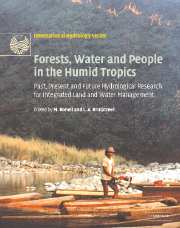 Forests, Water and People in the Humid Tropics
Forests, Water and People in the Humid Tropics from Part III - Forest disturbance, conversion and recovery
Published online by Cambridge University Press: 12 January 2010
INTRODUCTION
Selective forestry is a set of commercial forestry practices that involves the selective removal of particular trees within an ‘annual logging coupe’ of forest (Conway, 1982). Selective harvesting within ‘natural forests’ (i.e. those forests that have not been clearfelled for non-forest uses or converted to plantation or agroforestry) covers a very wide range of practices, including highlead and tractor yarding, harvesting of only large, commercial trees, protection of riparian vegetation along rivers and protection of forest on very steep hills. As a consequence, the intensities of the impacts on the water environment (i.e. water, nutrient and sediment systems) are expected to be very varied. Some of these impacts can be profound. One of the most significant environmental impacts of all types of forestry operations within the humid tropics is accelerated soil erosion (Bruijnzeel, 1992). The resultant input of sediments into rivers leads to damage to fish populations (Martin-Smith, 1998), reduced quality of water supplies, reductions in channel capacity which affects flood risk and boat traffic (Sheffield et al., 1995), and the inundation of offshore corals (MacDonald et al., 2001).
Development of selective harvesting techniques when applied to natural forests in the tropics are currently being focused on so-called ‘Reduced-Impact-Logging’ (RIL) or ‘closely supervised’ methods which aim to improve the ‘sustainability’ of timber production and reduce wider environmental damage.
To save this book to your Kindle, first ensure no-reply@cambridge.org is added to your Approved Personal Document E-mail List under your Personal Document Settings on the Manage Your Content and Devices page of your Amazon account. Then enter the ‘name’ part of your Kindle email address below. Find out more about saving to your Kindle.
Note you can select to save to either the @free.kindle.com or @kindle.com variations. ‘@free.kindle.com’ emails are free but can only be saved to your device when it is connected to wi-fi. ‘@kindle.com’ emails can be delivered even when you are not connected to wi-fi, but note that service fees apply.
Find out more about the Kindle Personal Document Service.
To save content items to your account, please confirm that you agree to abide by our usage policies. If this is the first time you use this feature, you will be asked to authorise Cambridge Core to connect with your account. Find out more about saving content to Dropbox.
To save content items to your account, please confirm that you agree to abide by our usage policies. If this is the first time you use this feature, you will be asked to authorise Cambridge Core to connect with your account. Find out more about saving content to Google Drive.